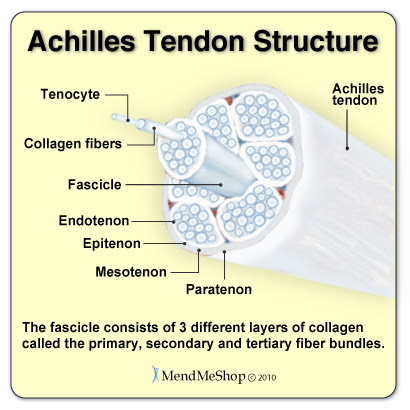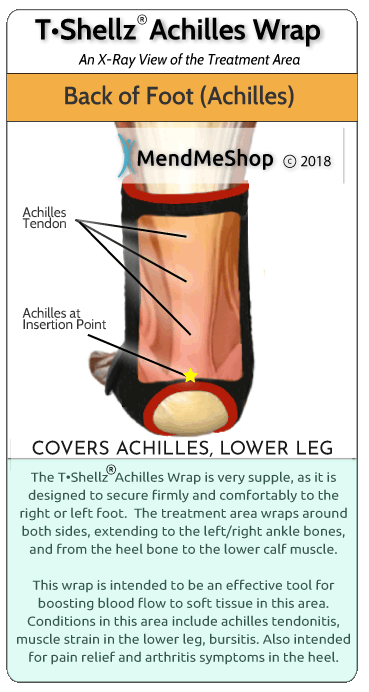Achilles Tenosynovitis Each tendon in your body has a protective sheath that helps the tendon stay lubricated (with synovial fluid) and glide smoothly between other soft tissue in the area. Injury to this 'sheath' means production of this synovial fluid is compromised or the fluid leaks outside the sheath. Either way, sheath damage often results in inadequate tendon lubrication. If you are suffering from an injury of this type to the Achilles tendon, the term is known as Tenosynovitis (or paratenonitis / peritendinitis). This basically means inflammation and degeneration of the tendon's outer layer or sheath. It is possible to suffer from Achilles tenosynovitis alone but usually it occurs alongside achilles tendinosis - a chronic degeneration of the achilles tendon. In cases of tendonosis, the tendon swells up so much that it often tears the sheath. As your body tries to heal the tendon sheath, scar tissue forms inside the sheath - creating attachments from the tendon to the paratenon (paratenon=sheath). This scar tissue limits the gliding movement of the tendon in the sheath, reducing range of motion and causing sharp pains, tenderness, redness and swelling. Symptoms of Achilles Tenosynovitis The pain you feel when you are suffering from Achilles paratenonitis (tenosynovitis) is usually a result of the inflammation in the tendon as well as the scar tissue that has built up between the tendon and the paratenon. When you move your Achilles tendon the scar tissue stops the tendon from gliding smoothly through the shealth. As the tendon moves, more tearing of the tissue occurs and more scar tissue begins to form as these tears heal. It's a cycle that needs to be broken by getting rid of the scar tissue. With Achilles tenosynovitis you may also experience:
Causes of Achilles TenosynovitisIn most instances, Achilles paratenonitis it is a result of repetitive strain or over-use that occurs over a period of time. It is common among runners and triathletes and is usually caused by improper training or weak tissue, such as:
The Key Points To Keep in Mind When Treating Your InjuryMake Sure That Complete Healing is Your #1 GoalWe all know that if the injury was healed, the pain would go away but what about the opposite situation? If the pain is gone, does that mean the injury is better? Unfortunately, this is not always true. Too many people only focus on suppressing pain symptoms while providing less attention to the true healing aspects of the body. Experiencing less pain, while obviously a good short-term goal, does not equate to underlying healing. Scar tissue can remain for months after one gets to a point of being relatively pain-free. However, as long the weak and brittle scar tissue remains, you are susceptible to re-injury or re-aggravation. Certain motions or movements can cause the weaker tissue to easily tear - resulting in some reversal of the recovery up until that point. This is why we recommend for people to continue with their doctor recommended exercises and to continue with mild treatments of the TShellz Wrap® for a period of time - to better ensure complete recovery. Ongoing treatments to enhance circulation are intended to soothe, relax and promote healing of damaged soft tissue in the application area. T•Shellz treatment also results in the ability of soft tissue to extend further due to the effect of heat on soft tissue. The more extensible your tissues are, the less likely they are to strain or sprain. Resting Your Ankle/Achilles Will Help, But Only TemporarilyPeople tell us all the time, "I was told that if I stay off my feet for a few weeks, my pain will disappear for good." The truth is, tendonitis pain is usually a culmination of numerous factors, such as repetitive stress, poor posture, acute injuries, and overcompensation issues resulting from other muscle and soft tissue ailments. To really deal with a injury, you have to know what the injury is - so get to the doctor and find out the source of the problem. Soft tissue damage in the lower leg and ankle is typically a result of a tear or strain in your muscle, tendon or ligament. Tendonitis, tendinopathy, tendinosis, tenosynovitis, nerve impingement, general ankle instability, calf muscle spasms, heel bursitis, capsulitis, pain associated with trigger points, scar tissue, and arthritis are not uncommon issues in the lower leg and foot, perhaps especially due to the enormous stresses caused by support the body's weight day in and day out. When dealing with arthritis and/or gout, soft tissue damage would be considered a secondary effect due to the underlying disease; in such cases, soft tissue pain and inflammation can be temporarily alleviated, but until the underlying cause is dealt with, the soft tissue damage will most likely return. It may take weeks or months for these pain triggers to surface. When they , however, merely resting will solve the underlying issues. You need to utilize actions and options that actually treat the source of the pain and help reverse the damage that has been done. Resting has a role to play, but it is only one small factor in a recovery plan. We Can Get You Started For Less Than The Cost Of A Few Clinic VisitsThe Next Step Is Up To You!Living with pain is never easy as it affects your entire lifestyle. Nothing is more important than making the proper decision when it comes to treating your muscle injury. Most methods only mask the problems or provide temporary relief; they do not treat the pain at its source. AidMyAchilles stands out in this regard as our goal is to help you heal for the longer-term. The bottom line is, you are welcome to try our products for a full 2 months. If you do not receive the benefits that others have experienced, simply return your purchase back to us and we will issue a prompt & full refund. There will be no hard feelings. The fastest option you have to get our product into your hands as soon as possible is by placing your order online - at this very moment.. If you choose to order through our online shop, know that we keep no credit card data on file. Once the transaction is completed, the credit information disappears from our internal systems. As you can see, ordering from us is a very easy and safe process, no matter if choosing to order on-line or over the phone. AidMyAchilles advisors do not work on commission, so be assured you will only receive fair and objective information. Learn More About Achilles Injuries & TreatmentsI want to learn more about Achilles Surgery & Post-Surgery Recovery I want to learn more about Circulation Boost I want to learn more about Ice & Heat: Which Is Better For The Achilles? I want to learn more about Stretching for the Achilles FREE SHIPPING ON ALL PRODUCTS CURRENTLY ENABLED |

Achilles Tendon Facts There are over 250,000 achilles tendon injuries each year in the US. Achilles tendon ruptures are common in people between the ages of 30 and 50. In runners, too rapid an increase in mileage, hill training without proper strengthening, and recent or inadequate changes to running gear can cause injuries to the Achilles tendon. Achilles tendonitis accounts for an estimated 11% of running injuries. 3-5% of athletes are forced to leave their sports career due to Achilles tendon overuse injuries that go untreated. Medications mask the pain but do very little in the healing of Achilles tendonitis. A fully ruptured tendon REQUIRES surgery. It will not heal on its own. Achilles tendonitis and Achilles tendinitis are the same thing. Continually using your Achilles tendon while it is injured will lead to a more serious and/or chronic injury.  |
